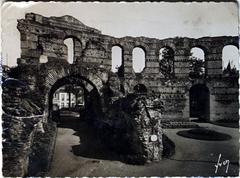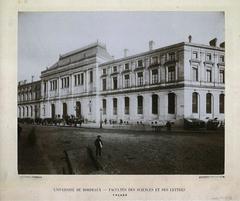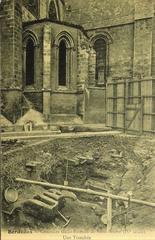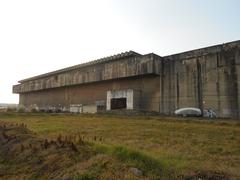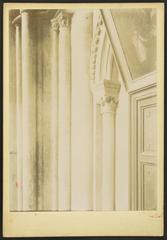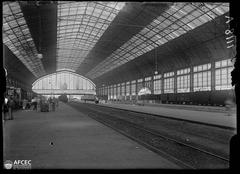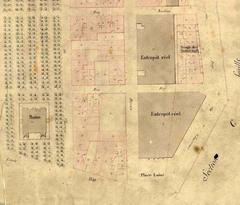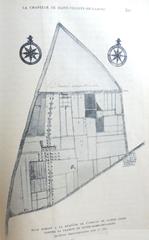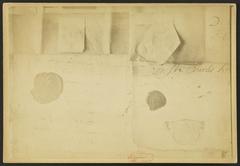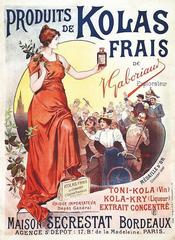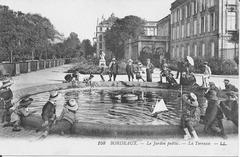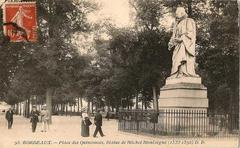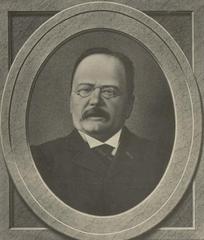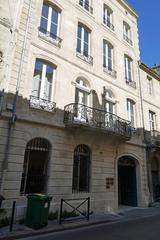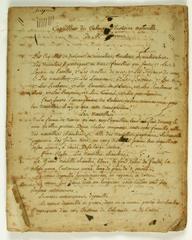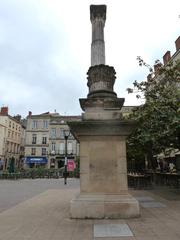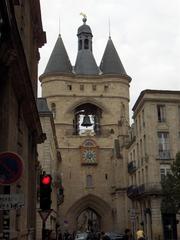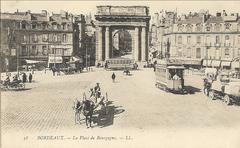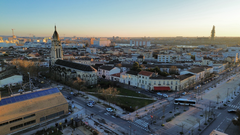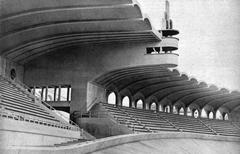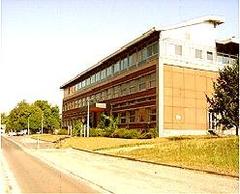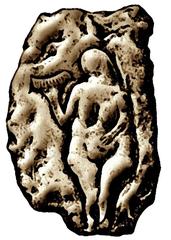Manufacture des Tabacs Bordeaux: Visiting Hours, Tickets & Historical Sites Guide
Date: 14/06/2025
Introduction
The Manufacture des Tabacs de Bordeaux is a landmark of industrial heritage, reflecting the city’s evolution from the 18th century through to the modern era. Once a major center for tobacco production under France’s state monopoly, the site now stands as a testament to Bordeaux’s economic, architectural, and social transformation. This comprehensive guide explores the site’s rich history, architectural features, cultural significance, and practical visitor information—including up-to-date details about visiting hours, ticketing, accessibility, and nearby attractions.
Table of Contents
- Historical Overview
- Architectural Heritage
- Social and Economic Impact
- Visiting Hours & Tickets
- Accessibility & Guided Tours
- Nearby Attractions & Travel Tips
- Preservation & Adaptive Reuse
- Frequently Asked Questions (FAQ)
- Summary & Visitor Information
- References
Historical Overview
From Royal Monopoly to Industrial Hub
Founded in 1721 as part of a royal initiative to centralize tobacco production, the Manufacture des Tabacs in Bordeaux rapidly became one of France’s largest tobacco factories. The factory’s strategic location near the Garonne River facilitated the import of raw tobacco and the export of finished goods across France and Europe (actuacity.com). The 18th and 19th centuries saw several expansions, including the construction of new production units and the iconic Bonfin façade, reflecting the factory’s growing economic importance (Wikipedia: Manufacture des tabacs).
Throughout its operational history, the factory employed thousands—particularly women—and played a pivotal role in Bordeaux’s urban and social development. By the eve of the French Revolution, the workforce numbered up to 1,500 people (POP: Plateforme ouverte du patrimoine).
Industrial Expansion and 20th-Century Transformation
The 19th century marked the golden age of the Manufacture des Tabacs, with technological advancements and the rise of mechanized production. The complex expanded to include new warehouses, workshops, and the signature clock building, which regulated the workday for hundreds of employees. The factory’s influence extended into the 20th century, weathering wars, modernization, and shifting consumer habits (espace-sciences-morlaix.org).
However, by the late 20th century, increased competition, automation, and changing public attitudes towards tobacco led to a gradual decline. The factory ceased production in 1987, and much of the original complex was demolished or repurposed. The historic Bonfin façade and central courtyard, however, were preserved as protected monuments (Monumentum).
Architectural Heritage
The Bonfin Façade and Site Layout
The most celebrated architectural element is the Bonfin façade, built in 1824 by architect Michel-Jules Bonfin. Characterized by classical symmetry, robust limestone masonry, and restrained ornamentation, the façade features twelve bays over two levels, with a prominent central projection (POP Culture, Gralon).
Behind the façade lies a courtyard bordered by a peristyle, serving both functional and social roles. Ancillary buildings—including the clock tower, warehouses, and workshops—reflect the evolution of industrial architecture from the 19th to the 20th centuries. These spaces were designed for efficient workflow and the well-being of a large workforce, particularly women, who made up a significant proportion of employees (POP Culture).
Heritage Protection
After its closure, the Bonfin façade, main entrance, and courtyard were designated as historic monuments. Today, these elements are integrated into the Espace Rodesse office complex, preserving the legacy of Bordeaux’s industrial past (Monumentum).
Social and Economic Impact
Community Identity and Labor History
The Manufacture des Tabacs shaped Bordeaux’s social fabric, fostering the growth of working-class neighborhoods and contributing to the city’s urban expansion (Wikipedia: Manufacture des tabacs). The factory was a microcosm of French industrial society: employment was stable, and women were notably prominent in its workforce. The rhythms of daily life, from work shifts to community gatherings, revolved around the factory, and it became a focal point for labor activism and social change.
Cultural Significance
The building’s transformation from factory to heritage site mirrors Bordeaux’s broader transition from industrial port to cultural capital. Oral histories, exhibitions, and public events commemorate the stories of former workers and the site’s role in the evolution of French industry (Sud Ouest).
Visiting Hours & Tickets
Opening Times
As of June 2025, the Manufacture des Tabacs is not open for daily public tours due to its conversion into office and institutional spaces. However, the preserved façade and courtyard are visible from Place Rodesse and can be appreciated from the exterior at any time.
Special access, including guided tours or open days (such as during the Journées du Patrimoine), is occasionally organized by local authorities or heritage organizations. For the latest information on visiting hours and ticketing, consult the Bordeaux Tourism Office agenda.
Ticketing
- General Admission: Viewing the exterior is free.
- Special Events: Guided tours or events may require ticket purchase. Fees vary according to the event. Advance booking is recommended for limited-access occasions.
Accessibility & Guided Tours
- Accessibility: The exterior and Place Rodesse are wheelchair-friendly. For special events or guided tours, check in advance with organizers regarding accessibility inside the complex.
- Guided Tours: Tours are offered during select events and heritage days, often in French and English. Availability, language, and group size may vary—always book ahead through the Bordeaux Tourism Office.
Nearby Attractions & Travel Tips
Location: Situated in central Bordeaux, the Manufacture des Tabacs is within easy reach of many top attractions:
- Place de la Bourse
- Jardin botanique de Bordeaux
- Musée de la Mer et de la Marine
- Musée d’Aquitaine
- Grosse Cloche
Transport: The site is accessible by tram, bus, bicycle, or on foot. Limited parking is available nearby.
Travel Tips:
- Check event schedules and book tours in advance.
- Combine a visit to the Manufacture des Tabacs with other Bordeaux heritage sites for a full day of exploration.
- Use the Bordeaux CityPass for discounts on multiple attractions.
Preservation & Adaptive Reuse
Following its closure, the Manufacture des Tabacs underwent significant changes, with most industrial buildings demolished and key heritage elements protected. The Bonfin façade and courtyard have been preserved and now form part of a modern office complex, setting an example for the adaptive reuse of industrial sites (Le Monde du Tabac). Ongoing collaborations with local institutions and architecture students imagine new ways to integrate the site into Bordeaux’s cultural life (Mairie de Tonneins).
Frequently Asked Questions (FAQ)
Q: Can I visit the interior of the Manufacture des Tabacs?
A: The interior is not regularly open to the public except during special events or heritage days. Check the Bordeaux Tourism Office agenda for upcoming opportunities.
Q: Is there an entry fee?
A: Viewing the exterior is free; guided tours or events may require a ticket.
Q: Is the site accessible for people with disabilities?
A: The exterior areas are accessible. For interior access during events, check with organizers in advance.
Q: Are there guided tours?
A: Occasionally, during special events or heritage days. Advance booking is advised.
Q: What are the best times to visit?
A: Early mornings or late afternoons offer optimal lighting for photography. Special events provide opportunities for guided exploration.
Summary & Visitor Information
The Manufacture des Tabacs Bordeaux offers a compelling lens into the city’s industrial, architectural, and social history. Its preserved façade and courtyard stand as enduring symbols of Enlightenment-era design and industrial ambition (Monumentum). Although daily public access is limited, the site remains a focal point for heritage events, educational programs, and cultural renewal (espace-sciences-morlaix.org).
For updated information on visiting hours, ticketing, and events, consult the Bordeaux Tourism Office or download the Audiala app for guided experiences across Bordeaux’s heritage sites.
References
- actuacity.com
- Wikipedia: Manufacture des tabacs
- Mairie de Tonneins
- Monumentum
- POP Culture
- Gralon
- Sud Ouest
- espace-sciences-morlaix.org
- Musée du Patrimoine
- Bordeaux Tourism Office
